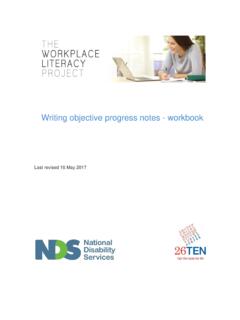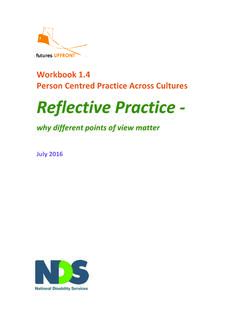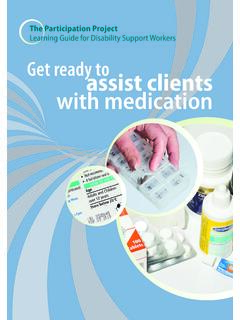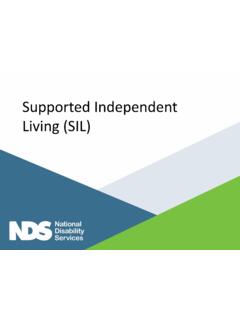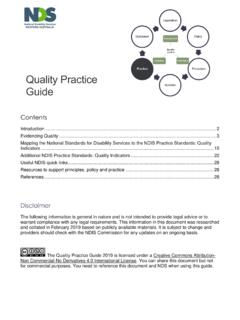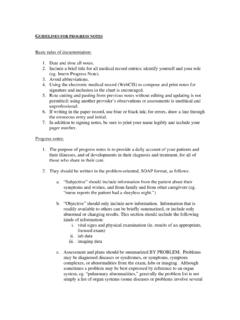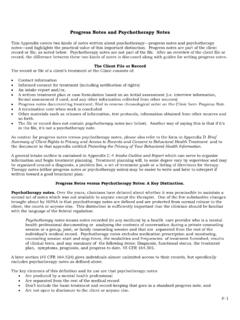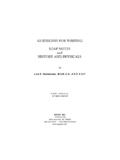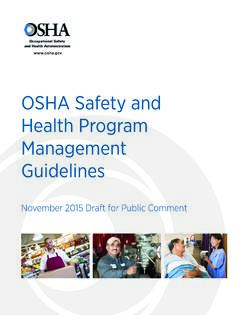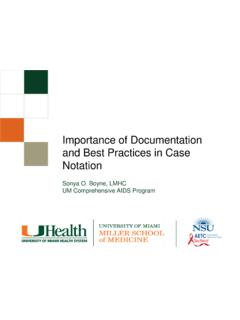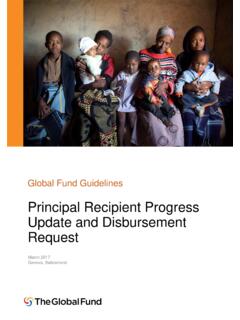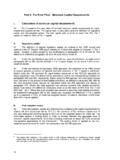Transcription of Creating exemplar progress notes with guidelines - Workbook
1 Creating exemplar progress notes with guidelines - Workbook Last revised 18 May 2017 1 About the program This training program is an action from the Tasmanian Disability Sector Language, Literacy and Numeracy Skills Action Plan 2016 - 2017. The aim is to work with a team to develop some exemplar progress notes with guidelines for their use. These can then be used by the team to train new and existing team members. This program involves a 1 hour, team-based training session. Session objectives At the end of this session you will understand more about progress notes . Your team will also have some draft exemplars and guidelines that you can use in the future. Note We use the term progress notes to refer to the documents created by support workers at the end of a shift. The term you use might be different from this, but the meaning will be similar. Other terms you might use are: Daily notes Client notes Case notes Shift reports Communication notes 2 What is an exemplar ?
2 An exemplar is something that is used as a typical example or model. Why make an exemplar ? An exemplar document is used to show someone an example of what you expect them to write. This can help keep the same standard between all documents produced. How is it used? You can show the person the exemplar and explain its features. You can then train them to create documents that are of the same standard as the exemplar . What are guidelines ? guidelines help people understand why different things are included in the exemplar document, and why some things are left out. They give information that helps make decisions while writing the document. Who makes exemplars? You do, and that s what we re doing during this session. What do they look like? On the next page there is an example of guidelines and an exemplar . The content of your documents might be different. guidelines and exemplars should reflect the way you do things in your organisation. They should help employees to follow the workplace policies and procedures.
3 3 guidelines for writing progress notes Only write about the things that are relevant to the person s plan, for example, Fiona s plan states that she wants to: o Socialise more o Do gardening as a way of being more active o Prepare meals independently o Learn more about cars Only include personal information that is directly relevant to the person s plan State what happened, the actions the person took; what you saw and heard If the person told you how they felt, and this is relevant to their plan, you can record what they said Do not report how you think they felt, unless it is relevant to the actions you took Do not write how you felt (this is important, but not in progress notes ) exemplar progress notes Fiona visited the gardening centre and asked a staff member some questions On the way home, she fuelled the van while I stood beside her At home, she did some household tasks with assistance She used her phone and sent some messages She prepared dinner, I assisted with turning on the stove and putting pots on and off the stove 4 5 Steps that we will follow Step 1 Choose the type of document Step 2 Identify the purpose and audience of the document Step 3 Plan the information needed in the document Step 4 Write your exemplar content Make notes for the guidelines as you go Step 5 Write the guidelines content Step 6 Check what you have written Step 7 Get feedback from colleagues and people who will use the documents Step 8 Think about their feedback, and edit Step 9 Design and produce your document Step 10 Get someone to proofread your document 6 Why do we write progress notes ?
4 The purpose of writing progress notes is: Who reads the progress notes ? The progress notes will be read and used by: 7 What is done with the information in progress notes ? How is the information used? What actions are taken based on the information? The information in progress notes is used to: What information needs to be reported in progress notes ? The information we need to include in progress notes is: 8 Write your exemplar content and make notes for guidelines as you go. We ll work together to do this. 1. Make up an imaginary person and create a simple person-centred plan for them (this will form part of the guidelines ) 2. Write progress notes for them for an imaginary fairly routine shift 3. Write progress notes for them for an imaginary unusual shift 4. If your team covers night and day shifts write one example for each TIPS Use bullet points to make it easier to read and write Use words that reflect the active support you provided (see the list on page 12) Use objective rather than subjective descriptions, that is words that describe the person s behaviour, not your perceptions about how they were feeling (see the table on page 13) As we work, make some notes here that can be used in the guidelines .
5 9 Write the guidelines content Share you notes about the guidelines you think should be included. Then we ll share them and work out one document for the team. Check what you have written Let s all read through both the guidelines and the exemplars quietly and make notes about anything that needs to be edited. 10 11 The last steps need to be done after the workshop. Your team leader will organise this with you. They will get feedback from anyone who wasn t in the workshop. They will also take it to other team leaders and managers for feedback. When the document is finished, they will come back to the team with the final draft. Reporting active support When you are reporting on the types of active support provided, explain the graded assistance that was given during each activity. Verbal cues you asked or invited the person to be involved Visual cues you set the scene so that the person could see what activity you were offering them Step-by-step instructions you gave the person clear and simple prompts at each stage of the activity Sign and gesture you moved your hands, arms, body or face to communicate an idea Show you did the same activity next to the person so they could copy you Physical assistance you provided some physical assistance to enable the person to complete part of a task Hand over hand assistance you placed your hand over a person s hand to help them carry out a task Visual aids you showed a person a picture or object to support them to make a choice Adaptive equipment the person used equipment to strengthen their physical or communication capabilities For example: Nugget made a zucchini cake.
6 He used speech-to-text to read the recipe from the internet at the start He used visual instructions to follow the recipe steps Physical assistance given to: o pick the zucchini from the garden o use the electric beater o put the cake into and out of the oven He worked independently to: o Get the utensils and cooking equipment ready o Measure the ingredients o Mix the dry ingredients o Scoop mixture into cake tin o Clean the kitchen Australian Government Department of Industry. (2015). Every moment has potential: Module 3 . Retrieved, February 2017, from Objective writing If you are thinking .. What did you actually see? Examples of other interpretations Happy The person: Smiled, and/or laughed Chatted Was quiet Engaged in their own activity independently Bored Wanting to please others Didn t know what else to do Aggressive The person: Threw objects Hit out at others Broke things Not knowing what is expected of them Frustrated or even threatened The requirements of the current situation exceed their skill or level of tolerance Other attempts to communicate are not responded to Attention seeking The person: Followed staff or family members around the house Touched others inappropriately Tried to pass objects at seemingly inappropriate times Teased others Interrupted others Acted in a way that seemed annoying Initiating relationships they want friends Seeking company they are lonely Seeking reassurance they are scared Seeking help or support they lack skills or confidence Personality issues Disruptive The person.
7 Talked or made noises at inappropriate times Yelled Interfered with the work or activities of others Broke things Frightened Scared Stressed Lacking understanding of the situation Continued overleaf If you are thinking .. What did you actually see? Examples of other interpretations Non-compliant The person: Did not do things as they were asked to do them Did not do things when they were asked Did not finish things they started Not interested Not understanding Not being asked the right way Not having sufficient skills Not having sufficient stamina (tired) Recalling bad memories of a past experience Self-injuring The person: Picked at their skin Cut themselves with a sharp object Placed objects in their body cavities Pulled their hair out Ate or drank to excess Nervous Anxious Depressed Psychiatric issues Bored/boredom Self-stimulating The person was: Rocking, twisting or play with their fingers and toes Slapping their face or their legs persistently Twirling around Poking at their eyes Humming or singing inappropriately Bored, overwhelmed or over stimulated and may need to calm Unable to identify or initiate an alternative activity Syndrome specific behaviours, possibly related to neurological problems Health and medical needs Adapted from: Department of Human Services, Victoria.
8 (2009). Positive behaviour support - Getting it right from the start: Facilitators reference manual V2. Retrieved, February 2017, from: Individual communication All behaviour is communication. Consider developing a communication chart for people who use diverse communication strategies. This will help the team recognise the messages people are trying to express with different behaviours. You can download this template and many other person-centred thinking tools from the Helen Sanderson and Associates website.
